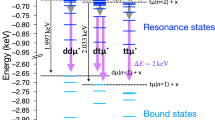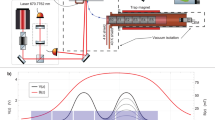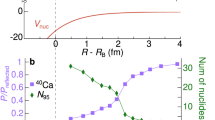Abstract
COLD fusion occurs when two nuclei with very small relative energy tunnel through their mutual Coulomb barrier to initiate a nuclear reaction. The phenomenon is well studied in muon-catalysed fusion1–4, where a relatively massive muon replaces an electron in a diatomic molecule of hydrogen isotopes, enhancing the binding and producing cold-fusion rates of ∼1012s−1. Cold fusion is also believed to occur as pycno-nuclear reactions in certain astrophysical environments5. Recent reports of cold fusion between hydrogen isotopes embedded in palladium6 and titanium7 have prompted us to reconsider previous estimates of the cold-fusion rates for free diatomic isotopic hydrogen molecules. In particular, we have calculated rates in diatomic hydrogen molecules of various isotopic composition. An accurate Born–Oppenheimer potential was used to calculate the ground-state wavefunctions. We find that the rate for d + d fusion is 3 × 10−64s−1, some 10 orders of magnitude faster than a previous estimate. We also find that the rate for p + d fusion is 10−55s−1, which is larger than the d + d rate because of the enhanced tunnelling in the lighter system. Hypothetical enhancements of the electron mass by factors of 5–10 would be required to bring cold-fusion rates into the range of recently claimed observations.
This is a preview of subscription content, access via your institution
Access options
Subscribe to this journal
Receive 51 print issues and online access
$199.00 per year
only $3.90 per issue
Buy this article
- Purchase on Springer Link
- Instant access to full article PDF
Prices may be subject to local taxes which are calculated during checkout
Similar content being viewed by others
References
Jackson, J. D. Phys. Rev. 106, 330–339 (1957).
Zel'dovich, Ya. B. & Gershtein, S. S. Soviet Phys. Usp. 3, 593–623 (1961).
Jones, S. E. Nature 321, 127–133 (1986).
Rafelski, J. & Jones, S. E. Scient. Am. 257, 84–89 (1987).
Shapiro, S. L. & Teukolsky, S. L. Black Holes, White Dwarfs and Neutron Stars 72–81 (Wiley, New York, 1983).
Fleischmann, M., Pons, S. & Hawkins, M. J. electroanalyt. Chem. 261, 301–308 (1989).
Jones, S. E. et al. Nature 338, 737–740 (1989).
Fowler, W. A., Caughlan, G. R. & Zimmerman, B. A. A. Rev. Astr. Astrophys. 5, 525–570 (1967).
Kolos, W. & Wolniewicz, L. J. chem. Phys. 41, 3663–3673 (1964); J. chem. Phys. 49, 404–410 (1968).
Byers-Brown, W. & Power, J. D. Proc. R. Soc. Lond. A 317, 545–574 (1970).
Koonin, S. E. Computational Physics 40–64 (Addison-Wesley, Menlo Park, 1985).
Van Siclen, C. D. & Jones, S. E. J. Phys. G 12, 213–221 (1986).
Slater, J. C. Quantum Theory of Molecules and Solids Vol. 1, 18 (McGraw-Hill, New York, 1963).
Messiah, A. Quantum Mechanics Vol. II, 786–800 (North-Holland, Amsterdam, 1965).
Leggett, A. J. & Baym, G. Nature (in the press).
Koonin, S. E. Phys. Rev. Lett. (submitted).
Leggett, A. J. & Baym, G. Phys. Rev. Lett. (submitted).
Picker, H. Nukleonika 25, 1491–1493 (1980).
Author information
Authors and Affiliations
Rights and permissions
About this article
Cite this article
Koonin, S., Nauenberg, M. Calculated fusion rates in isotopic hydrogen molecules. Nature 339, 690–691 (1989). https://doi.org/10.1038/339690a0
Received:
Accepted:
Issue Date:
DOI: https://doi.org/10.1038/339690a0
This article is cited by
-
Photon-induced low-energy nuclear reactions
Pramana (2022)
-
Possible generation of heat from nuclear fusion in Earth’s inner core
Scientific Reports (2016)
-
Theories of Variable Mass Particles and Low Energy Nuclear Phenomena
Foundations of Physics (2014)
-
Critical review of theoretical models for anomalous effects in deuterated metals
International Journal of Theoretical Physics (1994)
-
On the probability of cold nuclear fusion implementation: Synergetic hypothesis
Journal of Radioanalytical and Nuclear Chemistry Articles (1992)
Comments
By submitting a comment you agree to abide by our Terms and Community Guidelines. If you find something abusive or that does not comply with our terms or guidelines please flag it as inappropriate.



